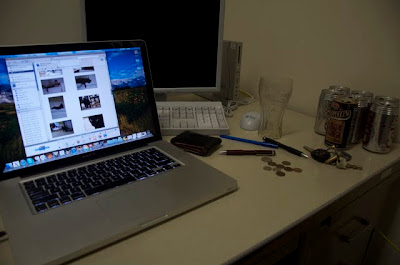Forums › Forums › Farktography General Chat › Farktography Pub and Grill › I got bored today. PREPARE FOR SCIENCE!
- This topic has 3 replies, 2 voices, and was last updated 12 years, 6 months ago by
aspidites.
-
AuthorPosts
-
October 5, 2011 at 2:33 am #2427
Plamadude30k
ParticipantHaving finished all the work my advisor set for me, and still waiting for him to send me more, I started playing around with my camera in my office today (I bring it every day, just in case, ya know?). I noticed that every once-in-a-while, I’d get a really weird looking image, like so:
And with various other states of weird orange banding.
However, at other times it would look perfectly normal:
In fact, I had noticed this effect two weeks ago when I had been testing my newest lens, the 50mm f/1.8. I put it down to the lens needing a hood (which it badly does), or possibly some weird white balance problem, but when I tested it out with my macro lens (which at macro focus has a speed around f/4-5ish), the effect seemed not to reappear. I ended up putting it down to the new lens and being pretty dissatisfied.
Now back to when I saw the effect today, I was using a different lens (18-105mm f/3.5-5.6), and I just happened to have the hood on. I also happened to be shooting in the D7000’s CH mode, which takes photos at approximately 6fps (the word *approximately* is important here). I found it especially interesting that the pattern had returned and seemed to *change* between photos. I set up to measure this like so:
My first thought was that it had something to do with the florescent lights in my office. A quick wikipedia search verified that fluorescents can change their color temperature at a frequency of 100-120 Hz (2 x mains frequency of 50 or 60 Hz). A perfect explanation! Well, almost. I don’t want to upload the whole dang series of photos (I kind of drained my battery investigating this…), but you can see that the pattern moves very slightly-in fact, it seems to precess from photo to photo. Since the CH setting on the D7000 is ~6fps and that exactly divides into 120 Hz, the pattern should be static. Since it’s not, I can conclude that my camera is (very) slightly slower than 6fps! NIKON LIED TO ME! My current theory is that it is slower than 6fps by the amount of time the shutter is open (for the images I was taking 1/8000s shutter speed, so fps = 6 frames / [1 second +6/8000]), but I haven’t been able to verify this yet, since I pretty much drained my camera’s battery. I was thinking of whipping up a nice lomb-scargle periodogram analysis program and taking long series of photos to really work it out, but then I realized that that was way too much work.
Anyway, to verify that I had correctly found the problem, I took photos at 1/60 (since I can’t do exactly 1/120 for some reason, this was the next best option) second exposures, and <<1/60 s exposures. The results are the first two photos I posted above. Since my 50mm f/1.8 was so fast, I was using the fast shutter speeds and catching just part of the florescent cycle, whereas when I was using my macro, I was at slower speeds (and lower light level), so I was using longer shutter speeds and averaging out the whole cycle. HA! TL;DL: I was really bored and figured out how to sync my shutter speed to fluorescent lights to get photos that don’t look weird.
October 5, 2011 at 3:16 pm #41544aspidites
ParticipantI found an article that might help you out with your experiment.
Did you try changing the while balance to either a fluorescent light or set a custom white balance?
October 5, 2011 at 8:42 pm #41545Plamadude30k
ParticipantYes, in fact, changing white balance was the first thing I tried. However, there are two problems with this:
1) Since the camera is measuring white balance slightly before it takes the photo and the color temperature of the light is changing, you’re seeing a different white point in the photo than is measured (at least this is how I understand it. I could be wrong).
2) The florescent WB setting is for the *average across the whole frame* spectrum of fluorescents. If you happen to catch it just right in the cycle, the color temperature (and therefore emitted spectrum) is completely different, but not across the whole tube. There is a differential change in emission, so you get the banding, which in camera terms means that WB is not even constant across a single frame, much less two adjacent frames.The comments concluded exactly what I did; sync shutter speed to a whole cycle or integer number of cycles, which in the US means using 1/30 s, 1/60 s, or 1/120s exposures, and in Europe means 1/25, 1/50, 1/100 s.
October 5, 2011 at 10:38 pm #41546aspidites
ParticipantYou could try a green gel on a flash to balance out the flourescent tubes.
I ended up doing that at a wedding I was shooting at Caesars Palace, but I had to use an orange gel to deal with the incandescence?s they had in the Chapel
-
AuthorPosts
- The topic ‘I got bored today. PREPARE FOR SCIENCE!’ is closed to new replies.